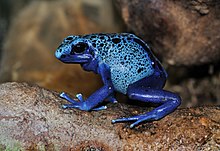Blue poison dart frog
| Blue poison dart frog | |
|---|---|
 |
|
|
Not evaluated (IUCN 3.1)
|
|
| Scientific classification | |
| Kingdom: | Animalia |
| Phylum: | Chordata |
| Class: | Amphibia |
| Order: | Anura |
| Suborder: | Neobatrachia |
| Family: | Dendrobatidae |
| Genus: | Dendrobates |
| Species: | D. tinctorius |
| Subspecies: | D. tinctorius "azureus" |
| Trinomial name | |
|
Dendrobates tinctorius "azureus" Hoogmoed, 1969 |
|
The blue poison dart frog or blue poison arrow frog or known by its native name, okopipi, (Dendrobates tinctorius "azureus") is a poison dart frog found in the forests surrounded by the Sipaliwini savanna, which is located in southern Suriname and adjacent far northern Brazil. D. tinctorius "azureus" is also known by its Tirio Indian name, okopipi. Its scientific name comes from its azure color. While frequently considered a valid species in the past, recent authorities treat it as a variant of D. tinctorius.
D. tinctorius "azureus" is a medium-sized frog that weighs about 8 g and grows to 3.0-4.5 cm in length. Females are larger and about half a centimeter longer than males, but males have larger toes. The frog has a typical lifespan of five to seven years in the wild. Its bright blue skin, usually darker around its limbs and stomach, serves as a warning to predators. The glands of poisonous alkaloids located in the skin serve as a defense mechanism to potential predators. These poisons paralyze and sometimes kill the predator. The black spots are unique to each frog, enabling individuals to be identified. This species of frog has a distinctive hunch-backed posture.
Each foot has four toes, which each have a flattened tip with a suction cup pad used for gripping. The tips of the toes in females are round, while males have heart-shaped tips.
As with almost all frogs, tadpoles differ greatly in appearance from adults. They have a long tail, about 6 mm, with a total length around 10 mm. They lack legs and have gills instead of lungs.
D. tinctorius "azureus" is a mainland animal, but stays close to water sources. These frogs spend most of their awake time, during the day, hopping around in short leaps. They are very territorial and aggressive both towards their own species and others. To ward off intruders, they use a series of calls, chases, and wrestling. Although poison dart frogs are known for their skin toxins, used on the tips of arrows or darts of natives, in reality only the species of the Phyllobates genus are used in this manner. In captivity, the frogs lose toxicity as a result of altered diets.
...
Wikipedia
